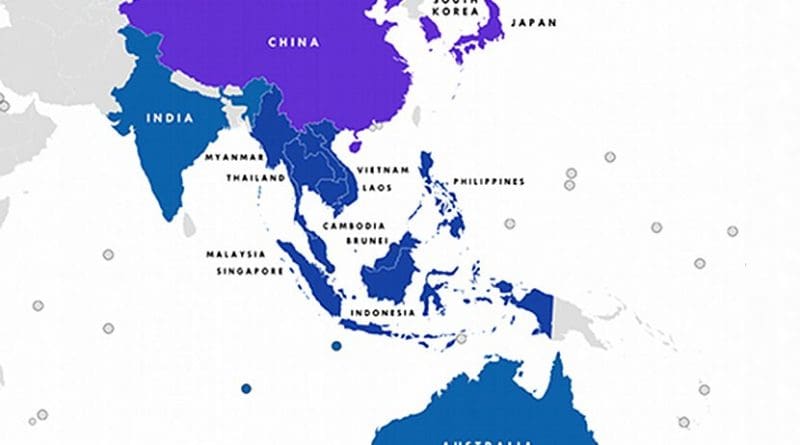RCEP May Turn Chinese Trade Trap For India – Analysis
RCEP (Regional Comprehensive Economic Partnership) may turn into a nightmare for India with China suspected to ploy a trade trap in the trade block. Hit by Trump’s fierce trade war, which will downsize China’s export, China is believed to offset the loss by aggressive exports to India through the platform of RCEP. In the trade block, China is the biggest exporter and India is the biggest consuming country because of its demographic advantage. Eventually, the real aim of India to be within the block will be defeated. It will succumb to bigger trade deficit.
China is the biggest stake holder in RCEP, which includes ASEAN 10 + 6 (China, Japan, Australia, South Korea, New Zealand and India). It accounts for more than one-fifth of member countries of RCEP. At present, India reels under trade deficit with RCEP members. Given the China’s predominance in RCEP, the major concern for India is that trade deficit would swell, leading to a paranoia of trade trap.
In 2017-18, RCEP accounted for 64.4 percent of India’s world trade deficit. China was the main cause for India’s trade imbalance with RCEP member countries. It accounted for 60.4 percent of India’s trade imbalance with RCEP.
The vulnerability of India’s joining RCEP cropped up when it was perceived that the trade block would impart a reverse impact on India. Instead of gaining in export, India will be a major import market . The major beneficiary will be China. The spill over impact of RCEP will prove double whammy for India, with China asserting for a new and big untapped market in India.
A close study of the trade relation between India and RCEP versus China in the represents that China will be the game changer. Given the China’s predominance in the block, critics cried foul , saying how can RCEP be a springboard for India’s export buoyancy? They feared that with the tariff concessions invoked in the block under FTA, it would leverage opportunities to China for larger eligible entry into Indian market and eventually the country would witness import surge from China, causing another dose of trade deficit.
Hitherto, China was exploring Indian market through backdoor using China –ASEAN FTA vis –a –vis India -ASEAN FTA. These FTAs became easy route for China to push its cheap products to India via ASEAN , while utilizing low tariffs. China signed FTA with ASEAN in 2010. Anecdotal evidences proved that since 2010, India’s trade deficit with ASEAN widened further. It increased by over 68 percent in between 2009 -2010 to 2017-18.
Another empirical evidence to prove China using FTA with ASEAN to make a backdoor entry into India was dramatic changes in the basket of imports from ASEAN. Imports of engineering and plastic goods from ASEAN doubled in between 2009-10 to 2017-18 , where China has a bigger propensity to produce cheap goods. These product groups accounted for 27 percent share in total imports from RCEP member countries in 2017-18, against 23 percent in 2009-10.
This made Indian policy makers wary to conclude the RCEP deal and adopt a dilly-dally approach in the last Singapore meeting. Nevertheless, India could snatch away the commitment from the members of the trade block for continuing the negotiations over to the next year, leaving the target of this year in abeyance.
India had several FTAs and CEPAs in the past. The common argument is that India roiled into a mess in utilizing FTA’s for its export buoyancy. According to estimates, not more than 5 percent of India’s exports utilized FTA routes.
What are the reasons which decimated FTA benefits to India. Broadly, there are three reasons which shadowed the use of FTA. They are low competence in manufacturing, inverted duty structure and strict Rules of Origin.
Inverted duty structure prohibits Indian exporters to benefit from the tax concessions under FTA. The inverted duty structure means where custom duty on imports of components, parts and intermediaries are higher than the finished products. Given this duty structure, it is uncompetitive to produce products for exportable purposes. Several industries depend on imported raw materials and components.
India’s competitiveness in manufacturing is low as compared to partner countries of FTAs. Big domestic market and protection by high tariff resisted Indian manufacturers to improve qualitative and cost-effective production. Advantage of low labour cost is eroded by low availability of skilled workers. Only 4.7 percent of working population are formally skilled in India against 24 percent in China.
As a result, Indian exporters failed to enter the export market with qualitative and cost competitive advantages. They are much behind of China and South East countries in manufacturing capability who developed export based model of economy.
Indian exporters expressed concern over Rules of Origin in some major partner countries under FTAs. According to a FICCI survey, who are mainly engaged in trade with major six countries of ASEAN, viz, Singapore, Malaysia, Indonesia, Thailand, Philippines and Vietnam, Rules of Origin were posing hurdles to Indian exporters. About 30 percent of the respondents exporting pharmaceuticals, automotive parts and chemical products to these countries highlighted the Rules of Origin as one of the main barriers to reap the benefit from FTA.
Given the past experiences of FTA utilization and trade structure between India and RCEP, where China will be the game changer, it presages a threat of trade trap by China. In the light of this, it is advisable for India to give second thought for participation in the trade block, unless changes are made in the original model. In this perspective, longer period of phase out of the tariff reduction, particularly in case of China and entry of service sector, with easing of visa regulation, are imperative.
Views expressed are personal

